ABSTRACT
Successful transmission of online multimedia streams in wireless multimedia sensor networks (WMSNs) is a big challenge due to their limited bandwidth and power resources. The existing WSN protocols are not completely appropriate for multimedia communication. The effectiveness of WMSNs varies, and it depends on the correct location of its sensor nodes in the field.
Thus, maximizing the multimedia coverage is the most important issue in the delivery of multimedia contents. The nodes in WMSNs are either static or mobile. Thus, the node connections change continuously due to the mobility in wireless multimedia communication that causes an additional energy consumption, and synchronization loss between neighboring nodes. In this paper, we introduce an Optimized Hidden Node Detection (OHND) paradigm. The OHND consists of three phases: hidden node detection, message exchange, and location detection.
These three phases aim to maximize the multimedia node coverage, and improve energy efficiency, hidden node detection capacity, and packet delivery ratio. OHND helps multimedia sensor nodes to compute the directional coverage. Furthermore, an OHND is used to maintain a continuous node– continuous neighbor discovery process in order to handle the mobility of the nodes.
We implement our proposed algorithms by using a network simulator (NS2). The simulation results demonstrate that nodes are capable of maintaining direct coverage and detecting hidden nodes in order to maximize coverage and multimedia node mobility. To evaluate the performance of our proposed algorithms, we compared our results with other known approaches.
RELATED WORK
In this section, related WMSN approaches are discussed. Previous works discuss maximizing the coverage area and detecting the hidden nodes in the fields of wireless sensor networking, ad-hoc networks, and robotics. However, little research has been done in wireless multimedia sensor networking. Some addresses an omnidirectional coverage problem in wireless sensor networks but it is not suitable for a bidirectional and an occlusion-free viewpoint. Numerous applications require bi-directional coverage, but existing coverage models are only suitable for traditional wireless sensor networks (WSNs), and do not support WMSNs.
OBSTACLE-DRIVEN NEGATIVE EFFECT STRATEGY METHOD
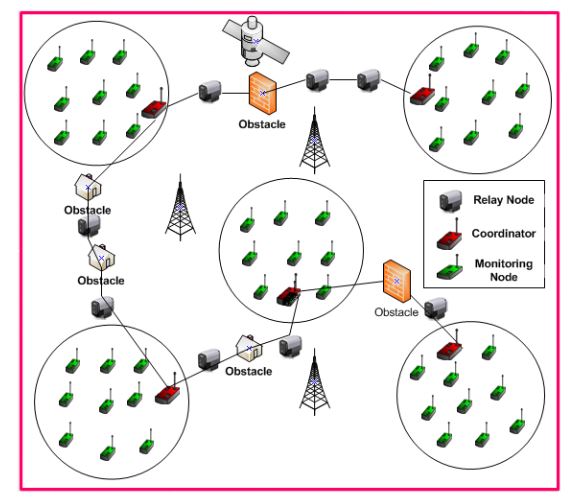
Figure 1. Showing the On-Demand Delivery process and obstacles
Here, we consider the wireless sensor network that is divided into several subdivisions and suffered because of disconnected subdivisions; it also experiences the issue of the obstacles among the subdivisions. In the network, each subdivision is controlled by the coordinator node. The coordinator node has a communication range ‘Rc’ that is the maximum Euclidean distance reached by the node’s radio.
OPTIMIZED HIDDEN NODE DETECTION PARADIGM
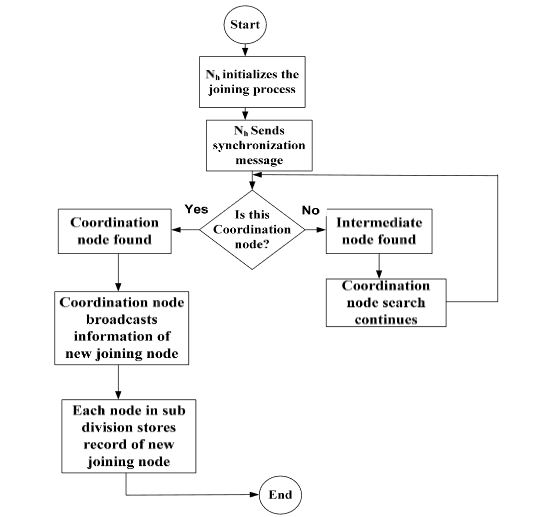
The synchronization message is dispersed over the entire links of the network to link with the coordination node. This is the way that the coordination node determines a new joining node is detected. When the coordination node has information about a new joining node that broadcasts within its subdivision nodes, the coordinating node will send out a message to all the nodes in the same subdivision. The synchronization process of a new joining node with the coordination node process is depicted in Figure 2.
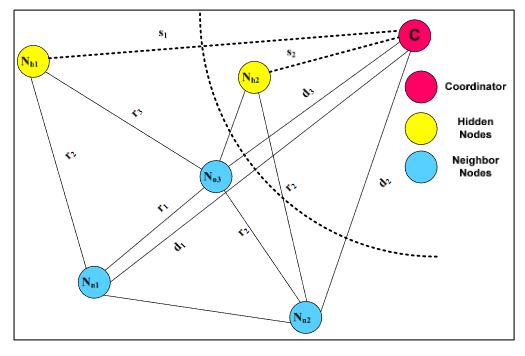
Figure 3. Hidden node discovery process
When the nodes that are available at the distance of a one hop neighborhood node of coordinator node receive the messages they start calculating distance from the coordinator node to detect the hidden nodes depicted in Figure 3. Let us assume that coordinator node ‘C’ has three neighbor nodes.
SIMULATION SETUP AND EXPERIMENTAL RESULTS
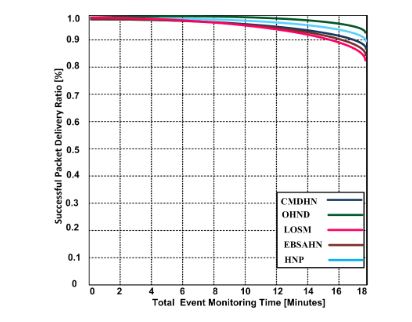
Figure 6. Successful packet delivery vs. number of monitoring events
Figure 6 demonstrates the results of our proposed OHND and its comparison with LOSM, EBSAHN, HNP, and CMDHN approaches. The performance is measured by using a various number of events. When the number of events increase, successful packet delivery ratio starts reducing.
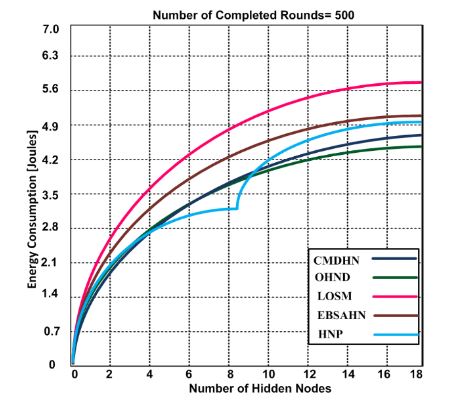
Figure 8. Energy consumption vs. number of hidden nodes
The performance of the OHND approach was evaluated by using 500 rounds with a constant frame size of 512 data frames (including payload and data frame format). We performed several runs to determine the energy consumption of our proposed approach. Figure 8 demonstrates the energy consumption of our proposed approach and compares it with other competing approaches in the presence of hidden nodes using a maximum of 500 rounds.
CONCLUSIONS
The hidden node problem creates a real threat to any type of multimedia wireless sensor network application. This paper introduces an optimized hidden node detection paradigm to improve the quality of service of the wireless multimedia sensor networks. Our paradigm consists of three phases: hidden node detection, message exchange phase, and location detection. These three phases resolve the hidden node problem and improve the network performance and QoS provision.
The message exchange phase is responsible for detecting overlapped and non-overlapped areas of multimedia sensor nodes. The location detection phase determines the correct location of each multimedia node which helps improve the coverage efficiency of multimedia sensor nodes. Furthermore, the hidden node detection phase identifies the load and residual energy of the nodes when performing the discovery process. To determine the strength of our proposed OHND, we used NS2 and also compared the performance with other competing approaches: LOSM, EBSAHN, HNP, and CMDHN.
The results demonstrate that our OHND improved multimedia coverage, energy consumption, and the packet delivery ratio when compared to other approaches. Furthermore, OHND has a hidden node detection capacity that is 0.8%–4.1% higher than the other the approaches. The simulation results confirm that our proposed paradigm is capable of determining hidden nodes for WMSNs application. In future research, we will implement our proposed OHND in a hardware-based environment.
Source: University of Bridgeport
Authors: Adwan Alanazi | Khaled Elleithy
>> More Wireless Sensor Networks Projects Abstract for Engineering Students
>> More Wireless Energy Projects for Engineering Students
>> More Wireless Projects Implementation in Ns2 for Engineering Students